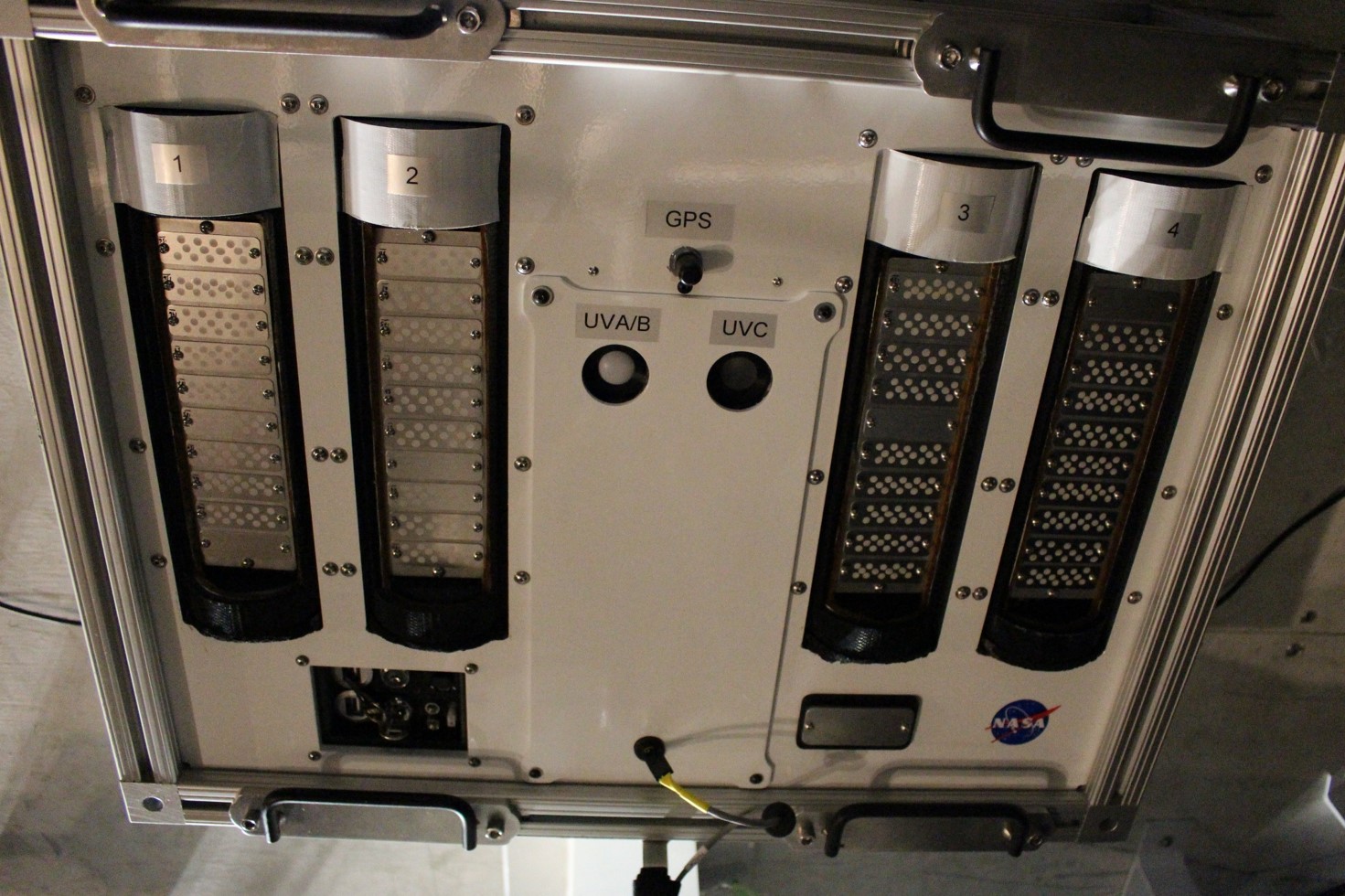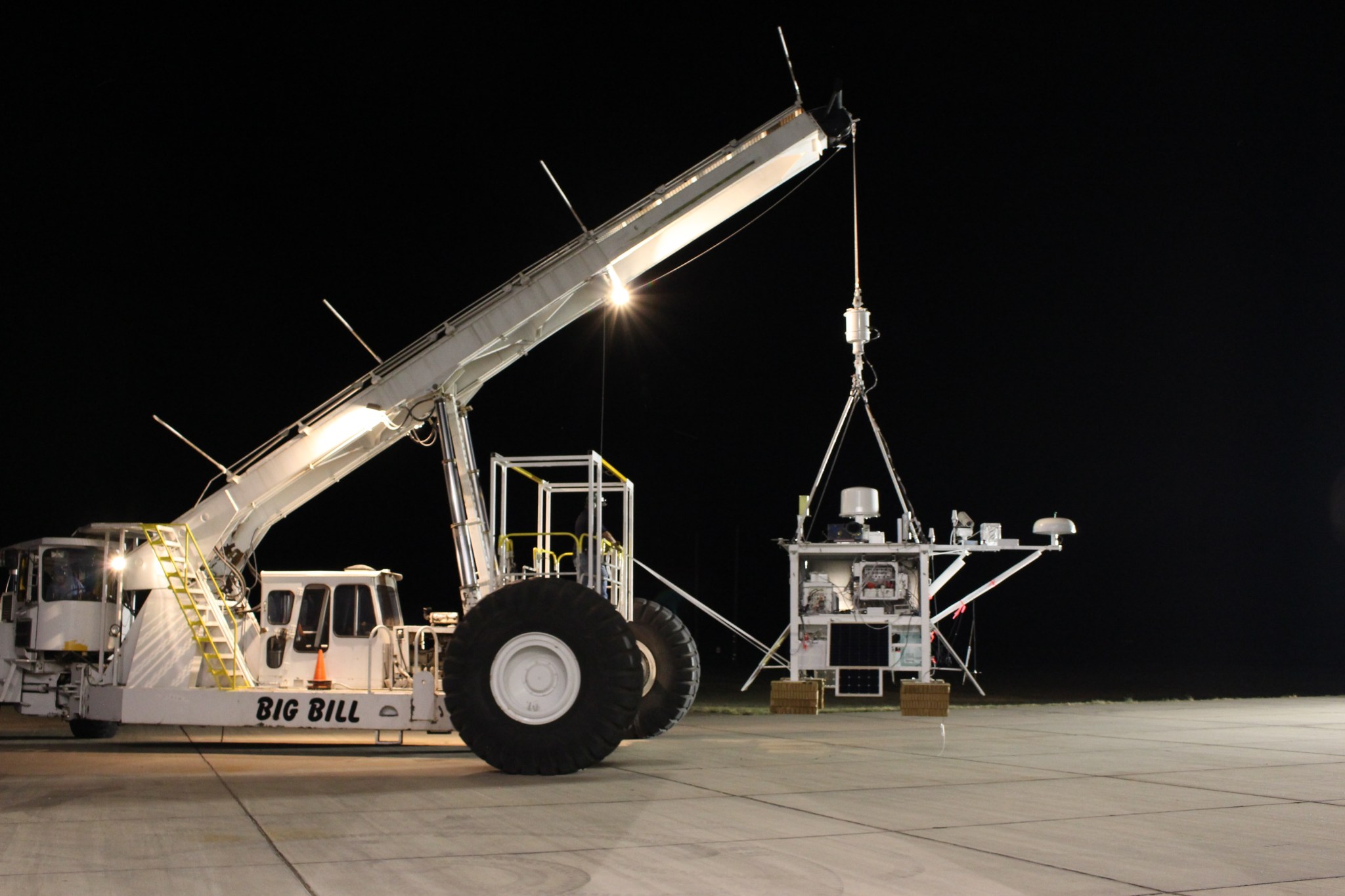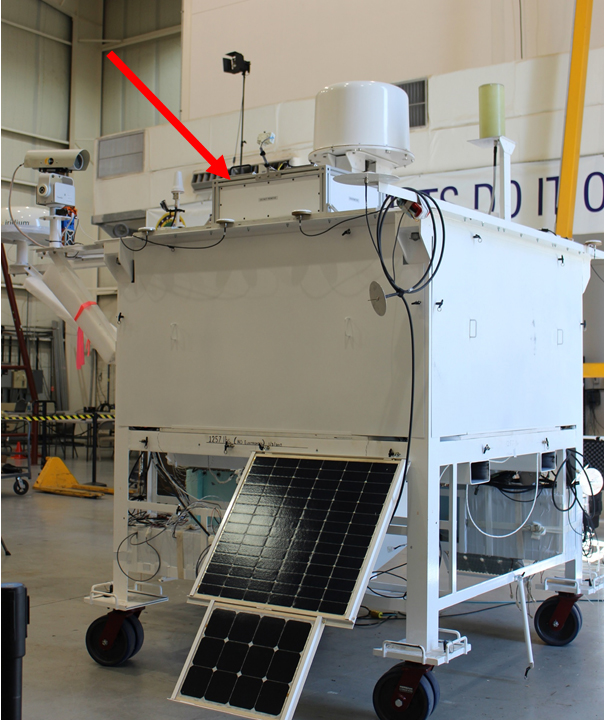Exposing Microorganisms in the Stratosphere (E-MIST) 2015 Flight Mission
Recent Press Update:
On March 28, 2017, Science and the Atlantic both wrote stories featuring David J. Smith and the E-MIST 2015 payload mission. It is great to see the public press’s interest in this NASA mission. Couple days later, NASA.gov did their own feature story covering the newly published results of the mission. Congratulations to the E-MIST team on their success!
———————————————————————————-
The Exposing Microorganisms in the Stratosphere (E-MIST) 2015 payload mission is a science investigation that is studying the survival of spore-forming bacteria carried to 125,000 feet above the New Mexico desert on a high-altitude NASA scientific balloon. The experiment launched from NASA’s Columbia Scientific Balloon Facility in Fort Sumner, New Mexico on Oct. 10. The payload transported known quantities of Bacillus pumilus SAFR-032, a highly-resilient bacterial strain originally isolated from a spacecraft assembly facility, to Earth’s stratosphere, an environment that mimics key surface conditions on Mars. The air is thin, cold, dry, and irradiated. NASA researchers are studying bacterial survival in this Mars analog environment to help NASA predict (and prevent) microbial contamination of the red planet by exploring spacecraft.
The E-MIST hardware system was developed at NASA’s Kennedy Space Center in Florida. This system was successfully flight tested in 2014. A report on the test flight was published in the December 2014 issue of Gravitational And Space Research. The second flight of E-MIST flight that launched on Oct. 10, 2015 was the first full science mission to use the hardware system.
During the mission, members of the public watched the progress of the flight unfold online by following the links to Fort Sumner Operations from NASA’s Columbia Scientific Balloon Facility website at: http://towerfts.csbf.nasa.gov/.
Mission Updates from E-MIST Principal Investigator, David J. Smith, Ph.D. at NASA’s Ames Research Center:
October 19, 2015
Success! E-MIST flew to the stratosphere and back on Oct. 10, 2015, launching from Ft. Sumner, New Mexico, at 8:41 am MDT, then landing approximately 10 hours later–208 miles to the northeast–in the Texas panhandle. The total time at our float altitude of 32 km above sea level was eight hours and 20 minutes, providing more than enough time for our primary science objectives to be satisfied. The payload operated exactly as it was designed, then returned to Earth with a soft landing adjacent to a dirt road in Texas, allowing the Columbia Scientific Balloon Facility staff to quickly recover the experiment and return it to the launch site in New Mexico. From there, the E-MIST samples were removed from the payload and shipped back to Kennedy Space Center for microbiological analysis. Our team looks forward to processing the results and sharing our findings in the coming months! We are grateful to the NASA Balloon Program Office at Wallops Flight Facility for the flight opportunity and the entire Columbia Scientific Balloon Facility staff for fantastic mission support.
October 10, 2015
E-MIST is launching today! Please use the links above to watch the action unfold.
October 9, 2015
The lingering weather front has finally dissipated, presenting another launch opportunity tomorrow (Oct. 10) from Ft. Sumner. Forecasted weather conditions are marginal but remain within the allowable parameters. The E-MIST payload will be picked up from the balloon integration facility at 3am MDT, then transported out to the flight line for a 7am MDT launch attempt if all goes according to plan. Tomorrow’s flight trajectory would carry the payload over towards the Northeast Texas panhandle. In the event of another launch scrub, the next opportunity will be Oct. 13.
October 6, 2015
– The Columbia Scientific Balloon Facility tried again to launch the E-MIST payload on LDB Test Flight II early this morning, but the launch was scrubbed due to wind speeds above acceptable limits. The next opportunity will most likely occur over the weekend, starting October 10.
October 1, 2015
– Another launch scrub this morning. Downrange precipitation was the problem. Our next possible launch window starts on Monday Oct. 5 and we will continue to provide updates on this website.
September 30, 2015
– Our early morning launch attempt on was scrubbed at 3:30 a.m. MDT because of thunderstorms east of Fort Sumner, where the balloon was expected to drift. Another launch possibility will occur tomorrow (Oct. 1) if the weather conditions stabilize, although the forecast looks somewhat marginal. Based on current CSBF models, weather conditions for Friday and Saturday will not permit a launch attempt.
September 29, 2015
– Good news – the local weather conditions have unexpectedly improved and LDB Test Flight II is go for another launch attempt tomorrow (Sept. 30) morning at 7:30 a.m. MDT. E-MIST team member Dr. Khodadad remains at the launch site and will work diligently throughout the evening to prepare our payload for a pickup at 3:30 a.m. MDT. If all goes to plan, the balloon gondola will be transported out to the flight line at 4:30 a.m. MDT and the CSBF live video stream will cover the entire sequence of events. Stay tuned!
September 28, 2015
– Weather conditions remain problematic for the E-MIST team and a launch this week seems unlikely. We communicate daily with the meteorologists from the Columbia Scientific Balloon Facility and our team will be back at Ft. Sumner to support the next available flight opportunity. Please continue checking this website for the latest information.
September 26, 2015
– The Sunday (Sept. 27) launch attempt has been postponed to no earlier than Monday (Sept. 28) due to unfavorable weather conditions.
September 25, 2015
– Congrats to the RaD-X team! RaD-X launched today under excellent weather conditions. The weather forecasted for Saturday is marginal, and the Columbia Scientific Balloon Facility staff must dedicate resources to recovering the RaD-X gondola; thus, the next launch attempt for the LDB Test Flight II that will carry E-MIST has been pushed back to Sunday, Sept. 27. The E-MIST team is on site and prepared for another launch attempt when the timing is right. Please stay tuned to this website and the CSBF links at the top of the page for the latest information.
September 24, 2015
– The weather system that has delayed our launch is clearing this afternoon. Another NASA mission called RaD-X is waiting in the launch queue at Ft. Sumner ahead of our flight. The balloon that will carry RaD-X is planned to launch tomorrow (Sept. 25) at 6 a.m. MDT. The LDB Test Flight II that will carry E-MIST is next in line after RaD-X for a launch attempt. If the local weather remains cooperative over the next two days, then launch of our E-MIST experiment is expected to occur on Saturday, Sept. 26.
September 21, 2015
– A persistent Pacific tropical moisture system will prevent launch attempts today, Tuesday and Wednesday. Based on the weather forecast, the next possible launch attempt will be Thursday Sept. 24 or Friday Sept. 25.
September 18, 2015
– We remain in a holding pattern for better weather. Tuesday Sept. 22 looks promising. In the meantime, this is a great opportunity to acknowledge the core 2015 E-MIST team members responsible for our project science and engineering:
- Dr. Christina Khodadad – Science Lead – NASA Kennedy Space Center
- Gregory Wong – Science (Intern) – NASA Kennedy Space Center
- Leandro James – Avionics Lead – NASA Kennedy Space Center
- Anthony Bharrat – Avionics – NASA Kennedy Space Center
- Emmanuel Carretero – Avionics (Intern) – NASA Kennedy Space Center
- Michael Lane – Electrical and Structures – NASA Kennedy Space Center
- Prital Thakrar – Mechanical Design – NASA Kennedy Space Center
- Adam Dokos – Mechanical Design – NASA Kennedy Space Center
- Nancy Zeitlin – Resources and Project Management – NASA Kennedy Space Center
- Anna Maria Ruby – Resources and Project Management – NASA Kennedy Space Center
- Dr. David J. Smith – Principal Investigator – NASA Ames Research Center
September 17, 2015
– So close, but the winds did not cooperate this morning. Our team reported to Ft. Sumner in the middle of the night to prepare our payload for launch, and the conditions were looking good enough to fly up until the last minute when a decision was made to scrub the attempt due to persistently strong surface winds (11-13 knots). We will try again tomorrow if the weather is favorable. Today’s scrub allowed us to implement and evaluate our launch procedures, which went smoothly, giving us confidence for the next flight opportunity. We will continue updating this website daily. For the link and on launch day watch the events unfold with live video stream on http://www.ustream.tv/channel/nas-csbf-operations.
September 16, 2015
– The weather forecast for Sept. 17 will permit our first launch attempt. Our team will report to Ft. Sumner in the early morning hours for a final assessment on weather conditions prior to flight. The approximate timeline:
- 2:00 a.m. MDT – E-MIST team arrives at Ft. Sumner
- 2:30 a.m. MDT – Balloon gondola rolls out to flight line
- 5:30 a.m. MDT – If balloon is still go for launch, E-MIST team installs science samples inside payload
- 7:00-7:30 a.m. MDT – Most likely window for launch
If the weather does not cooperate tomorrow morning, we will stand down and try again at the next available opportunity. A live video stream will show the entire sequence of events at Ft. Sumner. Please follow the links and instructions at the top of this website for accessing the video stream. Upon launch, the live stream will switch over from a ground view to a balloon gondola view. The ascent to the stratosphere will take about 45-60 minutes, and the E-MIST payload will be clearly featured in the video stream at various times during the balloon’s ascent and float.
September 15, 2015
– Compatibility testing concluded yesterday (Sept. 14) afternoon and our team spent the evening hours analyzing data logged by our payload instruments. All systems are operating as expected, and we are ready for flight. Now the waiting game begins, where we watch the weather and prepare for launch when the forecasted conditions are satisfactory. Wind speed, wind direction, and precipitation, among many other meteorological criteria, influence the final decision to launch. The conditions have to be favorable on the ground at Ft. Sumner, but also along the entire 125,000 ft column of air the balloon ascends and drifts through on its projected float across the southwestern United States stratosphere. Weather for tomorrow (Sept. 16) does not meet launch criteria, but the forecast for Sept. 17 and Sept. 18 seems better. Accordingly, a Flight Readiness Review with the NASA Balloon Program Office and the Columbia Scientific Balloon Facility staff will be held tomorrow (Sept. 16) afternoon at Ft. Sumner. If conditions are go, our team will return to Ft. Sumner in the very early morning hours (around 3am) to begin final preparations for launch. If not, we stand down until the following day, continuing with daily weather assessments. In the meantime, we are re-reviewing our launch and ground recovery procedures to make sure everything goes accordingly to plan on the flight day.
September 14, 2015
– Compatibility test is underway at Ft. Sumner. Our payload is in its flight configuration, powered on and attached to the balloon gondola, alongside the other flight systems. The gondola has been rolled outside of the integration facility at Ft. Sumner by the balloon launching vehicle affectionately known as “Big Bill” and it will remain outside for several hours, simulating payload activities that will actually occur in-flight. The goal of this dry run is to ensure that all of the payloads and flight systems are functioning as expected with no interference. Since most of the mission of opportunity payloads were designed, built, and tested at different facilities across the world, this test is an important and necessary way to verify that everything is compatible. If the results from the compatibility test are satisfactory, the NASA Balloon Program Office expects to conduct a Flight Readiness Review on Tuesday (Sept. 15) morning. Now that we are one step closer to launch, our second E-MIST team member, Leandro James, is traveling to Ft. Sumner today from Kennedy Space Center to support upcoming activities.
September 13, 2015
– E-MIST was mounted to the balloon gondola today. We are located on the uppermost portion of the gondola where our payload will receive full exposure to sunlight. The E-MIST payload was designed to be easy to install, and indeed, the whole operation took a matter of minutes, bolting the 80 pound hardware unit to the wooden gondola with several secure connections. The weather forecast does not look particularly great for the week ahead, but we are moving forward with flight preparations in case atmospheric winds stabilize. Not only does the weather have to be right at our launch site in Ft. Sumner, NM, but it also has to be acceptable hundreds of miles downwind at our projected landing site. Ballooning is a tricky business, highly dependent on accurate weather forecasting which our team gets from the very talented staff from the Columbia Scientific Balloon Facility. We are on track for a compatibility test tomorrow, where the E-MIST payload will be fired up for the first time since shipping from Kennedy Space Center. We will measure and monitor the payload’s performance while it sits on the ground with all of the other gondola payloads and guidance systems turned on as well, to make sure there’s no electrical or signal interference.
September 11, 2015
– E-MIST team member Dr. Tina Khodadad (from Kennedy Space Center) arrived at Ft. Sumner, New Mexico, this morning to work with the NASA Balloon Program Office (BPO) and the Columbia Scientific Balloon Facility (CSBF) staff in preparation for our upcoming flight opportunity. Dr. John Grunsfeld, Associate Administrator for the Science Mission Directorate, was visiting on site today, and we were grateful for the opportunity to brief him on E-MIST science objectives. Our hardware (shipping from Kennedy Space Center) was delivered in the afternoon, along with a separate shipment of bacterial samples. These bacteria have had a long and fascinating journey since their original isolation from a spacecraft assembly facility at the Jet Propulsion Laboratory nearly 10 years ago. Soon they will be flying to the stratosphere to face some of their toughest challenges yet. If the bacteria can tolerate the stratosphere, perhaps they could handle conditions on Mars as well. The E-MIST team intends to find out. Tomorrow is a day off for the CSBF staff, but we will be back to work on Sunday unpacking our payload and mounting it to the balloon gondola. We are preparing for a full systems compatibility test on either Sept. 14 or Sept. 15, depending on the weather conditions and the status of the RaD-X flight that is ahead of our planned mission. Another E-MIST team member, Leandro James (also from Kennedy Space Center), will be arriving to support the compatibility test on Sept. 14 and other activities related to launch and landing. Some quick facts about our upcoming flight:
- Flight Name = CSBF LDB Test Flight II
- Project Scientist = Bryan Stilwell
- Missions of Opportunity = E-MIST (Ames Research Center, Kennedy Space Center); ANS/Christl (Marshall Space Flight Center); EUSO IR/Adams (University of Alabama in Huntsville); JSAT CRM/Goyne (University of Virginia); MIRCA/Esper (Goddard Space Flight Center); and RLAGS/Fullmer (Utah State University)
- Balloon Size = 39.57 million cubic feet
- Lift Capacity = 6,000 lbs
- Launch Date = Tentatively Sept. 17 (weather dependent)
- Launch Time = Approximately 7:00 a.m. MDT
- Float Altitude = 127,000 feet above sea level
- Float Time = 18 hours (planned)
Learn More
Watch the NASA video, “B-Line to Space: The Scientific Ballooning Story”:




































